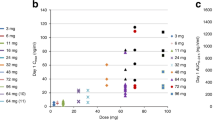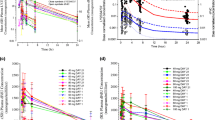Abstract
BACKGROUND
Etoposide dosing is based on body surface area. We evaluated if further dose individualization would be required for high dose (HD) etoposide within the TI-CE (taxol, ifosfamide, carboplatin, and etoposide) protocol.
METHODS
Eighty-eight patients received 400 mg/m2/day of etoposide as a 1-hour IV infusion on 3 consecutive days over 3 cycles as part of a phase II trial evaluating efficacy of therapeutic drug monitoring (TDM) of carboplatin in the TI-CE HD protocol. Pharmacokinetic (PK) data were analyzed using population PK model on NONMEM to quantify inter- and intra-individual variabilities. Relationship between etoposide exposure and pharmacodynamic (PD) endpoints, and between selected genetic polymorphisms and tumor response or toxicity were evaluated.
RESULTS
The inter-patient, inter- and intra-cycle variabilities of clearance were 16%, 9% and 0.1%, respectively. The PK-PD relationship was not significant despite a trend toward higher etoposide exposure in patients responding to treatment. A significant correlation was found between exposure and extended neutropenia at cycle 3. A significant association between UGT1A1*28 polymorphism and late neutropenia was observed but needs further evaluation.
CONCLUSIONS
The present study suggests that neither a priori dose individualization nor dose adaptation using TDM is required validating body surface area dosing of etoposide in the TI-CE protocol.

Similar content being viewed by others
Data availability
Data can be made available on request to the corresponding author.
References
Herzig RH. High-dose etoposide and marrow transplantation. Cancer. 1991;67(1 Suppl):292–8.
Birsen R, Willems L, Pallud J, Blanc E, Burroni B, Legoff M, et al. Efficacy and safety of high-dose etoposide cytarabine as consolidation following rituximab methotrexate temozolomide induction in newly diagnosed primary central nervous system lymphoma in immunocompetent patients. Haematologica. 2018;103(7):e296–9.
Fleming DR, Wolff SN, Fay JW, Brown RA, Lynch JP, Bolwell BJ, et al. Protracted results of dose-intensive therapy using cyclophosphamide, carmustine, and continuous infusion etoposide with autologous stem cell support in patients with relapse or refractory Hodgkin’s disease: a phase II study from the North American Marrow Transplant Group. Leuk Lymphoma. 1999;35(1–2):91–8.
Long GD, Chao NJ, Hu WW, Negrin RS, Wong RM, Blume KG. High dose etoposide-based myeloablative therapy followed by autologous blood progenitor cell rescue in the treatment of multiple myeloma. Cancer. 1996;78(12):2502–9.
Brown RA, Wolff SN, Fay JW, Pineiro L, Collins RH, Lynch JP, et al. High-dose etoposide, cyclophosphamide, and total body irradiation with allogeneic bone marrow transplantation for patients with acute myeloid leukemia in untreated first relapse: a study by the North American Marrow Transplant Group. Blood. 1995;85(5):1391–5.
Horning SJ, Negrin RS, Chao JC, Long GD, Hoppe RT, Blume KG. Fractionated total-body irradiation, etoposide, and cyclophosphamide plus autografting in Hodgkin’s disease and non-Hodgkin’s lymphoma. J Clin Oncol. 1994;12(12):2552–8.
Phillips GL, Wolff SN, Herzig RH, Lazarus HM, Fay JW, Lin HS, et al. Treatment of progressive Hodgkin’s disease with intensive chemoradiotherapy and autologous bone marrow transplantation. Blood. 1989;73(8):2086–92.
Motzer RJ, Mazumdar M, Sheinfeld J, Bajorin DF, Macapinlac HA, Bains M, et al. Sequential dose-intensive paclitaxel, ifosfamide, carboplatin, and etoposide salvage therapy for germ cell tumor patients. J Clin Oncol. 2000;18(6):1173–80.
Ratain MJ, Mick R, Schilsky RL, Vogelzang NJ, Berezin F. Pharmacologically based dosing of etoposide: a means of safely increasing dose intensity. J Clin Oncol. 1991;9(8):1480–6.
Miller AA, Tolley EA, Niell HB, Stewart CF, Griffin JP. Pharmacodynamics of three daily infusions of etoposide in patients with extensive-stage small-cell lung cancer. Cancer Chemother Pharmacol. 1992;31(2):161–6.
Minami H, Ando Y, Sakai S, Shimokata K. Clinical and pharmacologic analysis of hyperfractionated daily oral etoposide. J Clin Oncol. 1995;13(1):191–9.
Toffoli G, Corona G, Sorio R, Robieux I, Basso B, Colussi AM, et al. Population pharmacokinetics and pharmacodynamics of oral etoposide. Br J Clin Pharmacol. 2001;52(5):511–9.
Nguyen L, Chatelut E, Chevreau C, Tranchand B, Lochon I, Bachaud JM, et al. Population pharmacokinetics of total and unbound etoposide. Cancer Chemother Pharmacol. 1998;41(2):125–32.
Hande K, Messenger M, Wagner J, Krozely M, Kaul S. Inter- and intrapatient variability in etoposide kinetics with oral and intravenous drug administration. Clin Cancer Res. 1999;5(10):2742–7.
Joel SP, Shah R, Clark PI, Slevin ML. Predicting etoposide toxicity: relationship to organ function and protein binding. J Clin Oncol. 1996;14(1):257–67.
Ciccolini J, Monjanel-Mouterde S, Bun S-S, Blanc C, Duffaud F, Favre R, et al. Population pharmacokinetics of etoposide: application to therapeutic drug monitoring. Ther Drug Monit. 2002;24(6):709–14.
Moeung S, Chevreau C, Broutin S, Guitton J, Lelièvre B, Ciccolini J, et al. Therapeutic Drug Monitoring of Carboplatin in High-Dose Protocol (TI-CE) for Advanced Germ Cell Tumors: Pharmacokinetic Results of a Phase II Multicenter Study. Clin Cancer Res. 2017;23(23):7171–9.
Tranchand B, Amsellem C, Chatelut E, Freyer G, Iliadis A, Ligneau B, et al. A limited-sampling strategy for estimation of etoposide pharmacokinetics in cancer patients. Cancer Chemother Pharmacol. 1999;43(4):316–22.
Canal P, Michel C, Bugat R, Soula G, Carton M. Quantification of teniposide in human serum by high-performance liquid chromatography with electrochemical detection. J Chromatogr. 1986;375(2):451–6.
Yates CR, Zhang W, Song P, Li S, Gaber AO, Kotb M, et al. The effect of CYP3A5 and MDR1 polymorphic expression on cyclosporine oral disposition in renal transplant patients. J Clin Pharmacol. 2003;43(6):555–64.
Arbuck SG, Douglass HO, Crom WR, Goodwin P, Silk Y, Cooper C, et al. Etoposide pharmacokinetics in patients with normal and abnormal organ function. J Clin Oncol. 1986;4(11):1690–5.
Stewart CF, Arbuck SG, Fleming RA, Evans WE. Changes in the clearance of total and unbound etoposide in patients with liver dysfunction. J Clin Oncol. 1990;8(11):1874–9.
D’Incalci M, Rossi C, Zucchetti M, Urso R, Cavalli F, Mangioni C, et al. Pharmacokinetics of etoposide in patients with abnormal renal and hepatic function. Cancer Res. 1986;46(5):2566–71.
Stewart CF, Arbuck SG, Fleming RA, Evans WE. Relation of systemic exposure to unbound etoposide and hematologic toxicity. Clin Pharmacol Ther. 1991;50(4):385–93.
Wen Z, Tallman MN, Ali SY, Smith PC. UDP-glucuronosyltransferase 1A1 is the principal enzyme responsible for etoposide glucuronidation in human liver and intestinal microsomes: structural characterization of phenolic and alcoholic glucuronides of etoposide and estimation of enzyme kinetics. Drug Metab Dispos. 2007;35(3):371–80.
Marques SC, Ikediobi ON. The clinical application of UGT1A1 pharmacogenetic testing: Gene-environment interactions. Hum Genomics. 2010;4(4):238–49.
Minami H, Sai K, Saeki M, Saito Y, Ozawa S, Suzuki K, et al. Irinotecan pharmacokinetics/pharmacodynamics and UGT1A genetic polymorphisms in Japanese: roles of UGT1A1*6 and *28. Pharmacogenet Genomics. 2007;17(7):497–504.
Goey AKL, Sissung TM, Peer CJ, Trepel JB, Lee M-J, Tomita Y, et al. Effects of UGT1A1 genotype on the pharmacokinetics, pharmacodynamics, and toxicities of belinostat administered by 48-hour continuous infusion in patients with cancer. J Clin Pharmacol. 2016;56(4):461–73.
ACKNOWLEDGMENTS AND DISCLOSURES
The authors declare no potential conflicts of interest. The study was approved by the ethical committee Sud-Ouest et Outre-Mer I of Toulouse (reference number: 1-08-49).
Funding
This clinical trial (NCT00864318) was funded by a French Programme Hospitalier de Recherche Clinique (PHRC 2008 – project#18-08).
Author information
Authors and Affiliations
Contributions
Conception and design: C. Chevreau, E. Chatelut, F. Thomas, T Filleron
Study supervision: C. Chevreau
Acquisition of data (provided animals, acquired and managed patients, provided facilities, etc.): C. Chevreau, C. Massart, A. Fléchon, R. Delva, G. Gravis, J-P. Lotz, J-O. Bay, M. Gross-Goupil, S. Marsili, T. Lafont, C.Delmas
Analysis and interpretation of data (e.g., statistical analysis, biostatistics, computational analysis): S. Moeung, C. Chevreau, T Filleron, E. Chatelut, F. Thomas,
Writing, review, and/or revision of the manuscript: all authors.
Corresponding author
Additional information
Publisher’s Note
Springer Nature remains neutral with regard to jurisdictional claims in published maps and institutional affiliations.
Rights and permissions
About this article
Cite this article
Moeung, S., Chevreau, C., Marsili, S. et al. Pharmacokinetic and Pharmacogenetic Study of Etoposide in High-Dose Protocol (TI-CE) for Advanced Germ Cell Tumors. Pharm Res 37, 147 (2020). https://doi.org/10.1007/s11095-020-02861-5
Received:
Accepted:
Published:
DOI: https://doi.org/10.1007/s11095-020-02861-5




